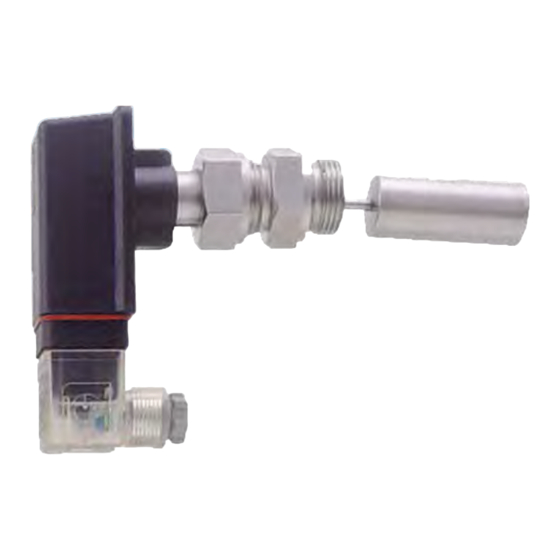
Table des Matières
Publicité
Les langues disponibles
Les langues disponibles
Liens rapides
Betriebsanleitung
Betriebsanleitung .................................................... Seite 1 - 16
Operating manual .................................................. page 17 - 32
Notice d'utilisation ................................................. page 33 - 48
Niveauwächter
Baureihen VH... / VK...
Bewahren Sie diese Betriebsanleitung zum Nachschlagen auf.
Geben Sie diese Betriebsanleitung bei der Veräußerung des Gerätes mit.
(Original)
Publicité
Chapitres
Table des Matières

Sommaire des Matières pour SIKA VH
-
Page 33: Contrôleur De Niveau
Betriebsanleitung ............ Seite 1 - 16 Operating manual ..........page 17 - 32 Notice d'utilisation ..........page 33 - 48 Contrôleur de niveau Séries VH... / VK... Conservez cette notice d'utilisation pour vous y reporter. Joignez cette notice d'utilisation à la vente de l'appareil. - Page 34 Consignes de sécurité ....................38 Personnel qualifié ..................... 38 Instructions spéciales de sécurité : ................38 Conditions supplémentaires pour le contrôleur de niveau VH...X ......39 Spécification des matériaux des composants mouillés ..........39 Montage du contrôleur de niveau ................40 Généralités ........................
-
Page 35: Indications Sur La Notice D'utilisation
VH... / VK... Indications sur la notice d'utilisation Indications sur la notice d'utilisation • La notice d'utilisation est destinée à un personnel formé et spécialisé. • Avant chaque étape de travail, lisez attentivement les indications correspondantes dans l'ordre indiqué. •... -
Page 36: Description De L'appareil
AVERTISSEMENT ! Aucun composant de sécurité ! Les contrôleurs de niveau VH... / VK... ne sont pas des composants de sécurité aux termes de la directive 2006/42/CE (directive sur les machines). N'utilisez jamais un VH... / VK... comme composant de sécurité. -
Page 37: Modèle De Contrôleur De Niveau Vh
Tenir compte de la séparation des zones : Les contrôleurs de niveau de la série VH...X sont conçu tel que l’intérieur de la conduite, où se trouve le flotteur, peut être soumis en permanence, pendant une longue période de temps ou souvent à... -
Page 38: Consignes De Sécurité
Les VH... / VK... correspondent à l'état actuel de la technique. Cela concerne la précision du point de commutation, le mode de fonctionnement et la sécurité du fonctionnement de l'appareil. -
Page 39: Conditions Supplémentaires Pour Le Contrôleur De Niveau Vh
Les plaques signalétiques ou autres indications sur l’appareil ne doivent être ni enlevées ni rendues illisibles, sinon la garantie et la responsabilité du fabricant expirent. 2.3 Conditions supplémentaires pour le contrôleur de niveau VH...X Le contrôleur de niveau ne doit être mis en contact qu’avec des milieux possédant une température d’allumage minimale >135 °C et une énergie d’allumage >60 µJ. -
Page 40: Montage Du Contrôleur De Niveau
32 ou molettes), ajuster le contrôleur de niveau et resserrer l’écrou. Les écrous d’accouplement en filetage G¾ en laiton ou en acier spécial (Modèle VH..) doivent être serrés avec un moment de serrage compris entre 25 et 30 Nm. -
Page 41: Branchement Électrique
Prenez note § 1.1.2 Contact reed - Commuter de charges inductives ou capacitaires. Conditions supplémentaires pour le contrôleur de niveau VH...X Le modèle de contrôleur de niveau VH...X peut être branché, comme du matériel élec- trique simple, sur un circuit électrique à sécurité intrinsèque certifié. -
Page 42: Prise Du Capteur M12X1 (À 4 Pôles)
Reed vert compensation /jaune de potentiel* Fig. 13 *) Afin d’éviter les charges électrostatiques, vous devez connecter les appareils à la compensation de potentiel par le câble de connexion fixe. - 42 - © SIKA • Ea1300_LevelSwitch • 04/2016... -
Page 43: Régler L'unité De Commutation
Si le client ne spécifie pas, l’unité de commutation est réglée en usine tel un contact de travail. 6.2 Modèle de contrôleur de niveau VH...X AVERTISSEMENT! PERTE DE LA PROTECTION CONTRE LES EXPLOSIONS! Pas de protection contre les explosions en cas de modification du type de contact ou du point de commutation. -
Page 44: Modèle De Contrôleur De Niveau Vh60
Fig. 18 Si le client souhaite que le réglage fin du point de commutation soit effectué en usine, le ré- glagede l’unité de commutation n’est pas à faire. - 44 - © SIKA • Ea1300_LevelSwitch • 04/2016... -
Page 45: Entretien Et Nettoyage
Élimination : PAS DE DECHET MENAGER ! Le VH... / VK... se compose de différents matériaux ( § 3). Il ne peut pas être jetée en- semble avec les déchets ménagers. Emportez le VH... / VK... à votre centre local de re- cyclage ... -
Page 46: Données Techniques
Les inductions et capacités internes effectives sont négligeables. 10 Homologations Les modèles de contrôleur de niveau SIKA sont homologués par le contrôle technique TÜV de Rhénanie, estampille de contrôle R 60077518 du 04.12.2012 (ne s'applique pas au modèle avec connec- teur de capteur M12x1). -
Page 47: Déclaration De Conformité Ue
VH... / VK... Déclaration de conformité UE 11 Déclaration de conformité UE Sous réserve de modifications techniques - 47 -... - Page 48 Flow Measuring Instruments Instruments de mesure de débit Test und Kalibriertechnik Test and Calibration Instruments Instruments de test et matériels de calibration SIKA Dr. Siebert & Kühn GmbH & Co. KG Struthweg 7–9 D-34260 Kaufungen Germany +49 (0)5605 803-0 ...




